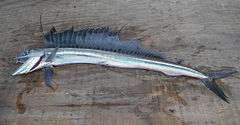Lancetfish
- For the United States Navy submarine, see USS Lancetfish (SS-296)
| Lancetfishes Temporal range: Middle Miocene-Recent[1] | |
|---|---|
 | |
| Longnose lancetfish, Alepisaurus ferox | |
| Scientific classification | |
| Kingdom: | Animalia |
| Phylum: | Chordata |
| Class: | Actinopterygii |
| Order: | Aulopiformes |
| Family: | Alepisauridae Swainson, 1839 |
| Genus: | Alepisaurus R. T. Lowe, 1833 |
Lancetfishes are large oceanic predatory fishes in the genus Alepisaurus ("scaleless lizard"), the only living genus in the family Alepisauridae.[2]
Lancetfishes grow up to 2 m (6.6 ft) in length. Very little is known about their biology, though they are widely distributed in all oceans, except the polar seas.[3] Specimens have been recorded as far north as Greenland.[4] They are often caught as bycatch for vessels long-lining for tuna.
The generic name is from Greek a- meaning "without", lepis meaning "scale", and sauros meaning "lizard".
Species
The two currently recognized extant species in this genus are: [5]
- Alepisaurus brevirostris Gibbs, 1960 (short-snouted lancetfish)
- Alepisaurus ferox R. T. Lowe, 1833 (long-snouted lancetfish)
The main difference between the two is the shape of the snout, which is long and pointed in A. ferox, and slightly shorter in A. brevirostris. There is a third recognized species, A. paronai D'Erasmo, 1923,[6] which is a fossil known from Middle Miocene-aged strata from Italy.
Description
Lancetfish possess a long and very high dorsal fin, soft-rayed from end to end, with an adipose fin behind it. The dorsal fin has 41 to 44 rays and occupies the greater length of the back. This fin is rounded in outline, about twice as high as the fish is deep, and can be depressed into a groove along the back. The body is slender, flattened from side to side, deepest at the gill covers, and tapers back to a slender caudal peduncle.
The mouth is wide, gaping to the back of the eye, and each jaw has two or three large, fang-like teeth, in addition to numerous smaller teeth. The caudal fin is very deeply forked; its upper lobe is prolonged as a long filament, although most lancetfishes seem to lose this when captured. The anal fin originates under the last dorsal ray, and is deeply concave in outline. The ventral fins are about halfway between the anal fin and the tip of the snout, while the pectoral fins are considerably longer than the body is deep and are situated very low down on the sides. No scales are present, and the fins are very fragile.
Ecology
Lancetfish have large mouths and sharp teeth, indicating a predatory mode of life. Their watery muscle is not suited to fast swimming and long pursuit, so they likely are ambush predators, using their narrow body profile and silvery colouration to conceal their presence, then use their large dorsal fin to generate large acceleration, and large mouth and teeth to engulf prey before it can escape. Stomach content studies have revealed they feed mainly upon planktonic crustaceans, squid, and salps, as well as other fish. They have also been shown to be cannibalistic, leading to the nickname of "cannibal fish."[7] They are preyed upon by opah, sharks, albacore, yellowfin tuna, and fur seals.
No commercial fisheries exist for lancetfishes. Their flesh is watery and gelatinous, and although edible, would prove difficult to use in human cuisine or industry. They are caught as bycatch by tuna fisheries, and are seen as pests, taking bait intended for more valuable species. Anecdotal evidence suggesting they have an aphrodisiac effect is likely to be an urban myth.
The tetraphyllidean tapeworm Pelichnibothrium speciosum is a significant parasite of long-snouted lancetfish. The species seems to be an intermediate or paratenic host for the tapeworm. [8]
Reproduction
The reproductive system of lancetfish is something of a mystery. The gonads of adolescents have been shown to be hermaphroditic, although no evidence of functional hermaphroditism is seen in adults. They are oviparous.
References
- ↑ Sepkoski, J. (2002). "A compendium of fossil marine animal genera". Bulletins of American Paleontology 364. Retrieved 2008-01-08.
- ↑ Froese, Rainer, and Daniel Pauly, eds. (2006). "Alepisauridae" in FishBase. February 2006 version.
- ↑ Kubota, T.; Uyeno, T. (1978). "On some meristic characters of lancetfish, Alepisaurus, collected from Suruga Bay, Japan". Journal of Faculty of Marine Science and Technology, Tokai University 11: 63–69.
- ↑ Jensen, A. S. (1948). Contributions to the Ichthyofauna of Greenland. Skrifter Univ. Zool. Mus. Københaven 9. pp. 1–182. OCLC 83357750.
- ↑ Froese, Rainer, and Daniel Pauly, eds. (2012). Species of Alepisaurus in FishBase. February 2012 version.
- ↑ Uyeno, Teruya. "A Miocene alepisauroid fish of a new family, Polymerichthyidae, from Japan." Bull. Nat. Sci. Mus 10 (1967): 383-394.
- ↑ Docksai, Rick (19 May 2014). "Cannibal fish washes ashore in Nags Head, North Carolina". Science Recorder. Retrieved 20 May 2014.
- ↑ Scholz, T.; Euzet, L.; Moravec, F. (1998). "Taxonomic status of Pelichnibothrium speciosum Monticelli, 1889 (Cestoda: Tetraphyllidea), a mysterious parasite of Alepisaurus ferox Lowe (Teleostei: Alepisauridae) and Prionace glauca (L.) (Euselachii: Carcharinidae)". Systematic Parasitology 41 (1): 1–8. doi:10.1023/A:1006091102174.
External links
| Wikimedia Commons has media related to Alepisauridae. |